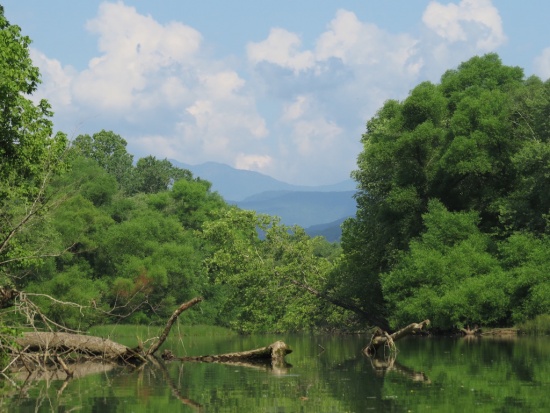| This article is incomplete. This article is missing one or more sections. You can help the BirdForum Opus by expanding it. |

Photo © by hamhed
McDowell County in Western North Carolina July, 2020
Overview
Western North Carolina (WNC) is an area of diverse examples of nature, geography, and habitat.
It begins in an area of gentler, rolling hills around Wilkes, Burke, and Rutherford counties and extends westward to the Tennessee-North Carolina border areas in the midst of the peaks, and vistas, of the Great Smoky Mountains and Appalachian Mountain Ranges.
It is an area of middle-size cities and towns in the eastern portion and of increasingly smaller communities and towns in the more rugged western portion.
It’s a region of gently meandering streams and rivers on the one hand while having within it’s bounds, world-class white-water in the Nantahala area.
It’s gentle, idyllic trout streams in an area where Black Bear and Elk roam.
It’s birds as small as a sparrow and as majestic as a Bald Eagle.
It’s flora and fauna from one end of the spectrum of nature to the other.
It “is” as author Christian Reid said, in the title of the 1876 book, “The Land of the Sky.”[1] A nickname that is frequently used to refer to the far western portion of Western North Carolina to this day.
Birds
Notable Species
The term “notable, when it comes to describing species of birds, as it applies to Western North Carolina, is a term as widely interpreted as the landscape and people of the region. It is definitely worth noting the venerable Bald Eagle has been reported to some amount in all counties in this part of the state.
Other oft reported species of birds in the area are the Broad-winged Hawk, Common Grackle, Pine Siskin, Swainson's Thrush, American Robin, Red-winged Blackbird, European Starling, Song Sparrow, Canada Goose, Tree Swallow, Turkey Vulture, and Northern Rough-winged Swallow among others.
Rarities
Species seen, but not often, can include Summer Tanager, Nashville Warbler, Dickcissel, Wilson's Warbler, Cerulean Warbler, Kirtland's Warbler, Western Tanager, Black-capped Chickadee, Bay-breasted Warbler, Prairie Warbler, Connecticut Warbler, Yellow-throated Warbler, and Blue Grosbeak.
Check-list
Birds you can see here include:
In addition to those species you saw in the oft-reported list under “Notable Species”, you might want to add these to the list as species you might see. The Chimney Swift, Downy Woodpecker, Common Nighthawk, Common Raven, Vesper Sparrow, Eastern Kingbird, Pileated Woodpecker, Little Blue Heron, Spotted Sandpiper, Worm-eating Warbler, Marbled Godwit, White-eyed Vireo, Double-crested Cormorant, Cliff Swallow, Wood Duck, Brown Thrasher, Winter Wren, Wood Thrush, and Northern Parula.
Other Wildlife
To do
Site Information
History and Use
To do
Areas of Interest
When it comes to matters of travel and tourism, be that for birding, business, or some other type of get-away, there exists no greater resource than the North Carolina Travel and Tourism people through their official website, Visit NC[1]. It will be a mix of all things travel and tourism-related be they free to the public, or otherwise. They also have "a ton" of information to include free maps and brochures they will send to you to help you plan your trip.
National Parks, Parkways, Reserves, and Preserves etc.
Blue Ridge Parkway
The Blue Ridge Parkway is one of the best ways to traverse a good portion of Western North Carolina/ And in doing so is also a first class collection of wonderful sites for birding and all manner of ways to enjoy nature. It’s more than “A” site, but an assembly of sites stretching for 469 miles, covering parts of 2 states with more sites, trails, waterfalls, etc. than you can imagine. You owe it to yourself to take a long, hard look at this one!
State Parks, Forests, and Trails, etc.
Chimney Rock State Park
Chimney Rock is one of those places that people always considered as their destination when they “went to the mountains” in Western North Carolina. It was, and still is, that kind of place. It is now known as[Map 1] Chimney Rock State Park[2] having achieved that status in 2007. However, access to the “Chimney” portion still has an admission charge. Parts of the park are free while others will require paying an admission. For instance, of the 10 trails present in the park, 6 are in the admission portion while 4 are in the free portion. There are still opportunities for birding without paying, if you so wish. The free access is through the Rumbling Bald access, the Eagle Rock Reserved Parking Area, and in Chimney Rock Village. Consult the park website[2] for specific, up-to-date information on other activities and park information
Grandfather Mountain State Park
Grandfather Mountain is another of the iconic spots when people think about going to the Western North Carolina mountains. It’s an easily recognizable view on the horizon when in the area. It always has offered many unique opportunities to enjoy nature and operated as a commercial entity until 2009 when the state purchased in excess of 2400 acres from the owners of Grandfather Mountain forming[Map 2] Grandfather Mountain State Park[3]. While an admission charge is still required for admittance to the upper portion of the mountain where the swinging bridge is located, there are many opportunities for enjoyment of nature, including birding, in the remaining portion. There are too many possibilities available to list here, so consult the park website[3] for additional, specific, and up-to-date park information.
Access and Facilities
To do
Contact Details
To do
References
- “The Land of the Sky”, a book by author Christian Reid, Published 1876 by then Publisher D. Appleton & Company.
External Links
- Official State of North Carolina Travel and Tourism website
- Chimney Rock State Park
- Grandfather Mountain State Park
Maps





